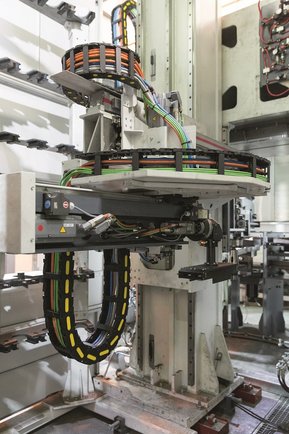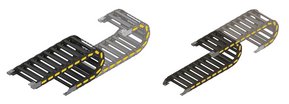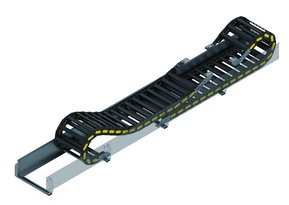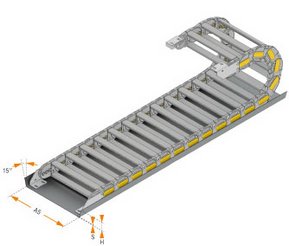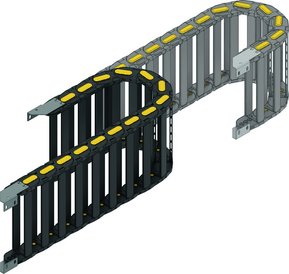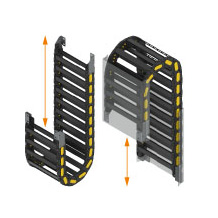With a pronounced urge to move: cable chains in automated applications

When you hear word automation, everyone agrees: processes are required that are as precise, reliable and fast as possible, that can be cyclical and work around the clock. Without exception. Cable chain systems are an indispensable part of process automation, as almost every production site can find applications in which machine parts need to be continuously supplied with power, data or media, such as air and water. On this page, you will find out what exactly is meant by a cable chain, when it is used, which materials are available for cable chains, what arrangement and assembly options are available, and last but not least what you need to keep in mind when selecting the appropriate cables.
What is a cable chain and what task does it perform?
A cable chain is a mechanical system that protects, supports and guides cables and media hoses in permanently moving machine applications.
The movements in the cable chain are performed in a controlled manner so that the forces permanently acting on the cable or the media hose do not cause premature damage or failure. Cables and media hoses are ultimately subjected to millions of bending movements along the travel distance in the cable chain.
Are cable chains and power chains the same?
A cable chain is exactly the same as a power chain, or a power guiding chain, cable drag chain or cable carrier.
However, LAPP deliberately calls this system a cable chain, as it protects, carries and guides much more than just power cables.
In our eyes, the phrase drag is a very good illustration of the function and performance of a cable chain, as its definition states “pulling something behind itself under a great deal of effort/strain and moving it somewhere”.
What are the main functions of a cable chain?
It allows the electrical, optical, hydraulic or fluidic connection between two points in linear movement in an easy and economical way.
It guides and supports the cables and hoses contained in a controlled manner, while observing the minimum permissible bending radius.
It provides mechanical protection for cables and hoses and even separates them from chemical environmental influences if they are enclosed with protective covers.
This not only reduces the number of maintenance intervals for cables and hoses, but also increases their service life.
Where are cable chains used?
Cable chains are one of the most gruelling usage locations for cables. In a cable chain, power, servo and data cables are located close together and move back and forth as a machine works. Sometimes faster than five metres per second with more than five times the acceleration of gravity. They supply moving machine parts with power, signals, data or even compressed air and liquids. Cable chain systems have proven themselves for many years in all applications where movements are automated and continuously carried out.
Successful reference stories from LAPP
What advantages does a cable chain have compared to cable trolley systems?
Competitive advantages of the cable chains as compared to the traditional systems, like conductor bars and festoon suspensions and cable trolley systems are:
- they shine thanks to the ability to carry different kinds of utilities (power, signal and data cables as well as hydraulic and pneumatic hoses),
- they can be used unconditionally in critical environments where dust, moisture, chemicals and aggressive substances can be present in the atmosphere on a daily basis.
- they can withstand high speeds and accelerations.
- Cables can be installed, replaced or installed at a later date.
- In addition to horizontal, vertical, diagonal and circular travel distances are also possible.
- Maintenance work is easy to carry out, but it is generally less maintenance-intensive.
- They require a much lower media length for comparable travel distances, as the media are linear in the cable chain rather than sagging.
Which cable for the cable chain?
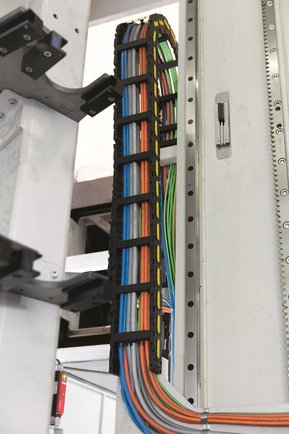
Cables and hoses suitable for cable chains are sometimes flexed very strongly continuously. As a result, they are permanently exposed to the stresses resulting from the bending movement in the cable chain. Unlike three-dimensional torsional movements, this bending movement is always linear and always in one direction.
The flexibility of a cable has a direct impact on its bending radius, which indicates how much a cable can be bent without impairing its functional capability.
The tighter the bending radius, the greater the stress on the cable and the more difficult it is to achieve the long service life required.
Remark: If cables and hoses are bent very strongly in the cable chain, this has the following effects:
- the longest possible travel distance,
- maximum permissible travelling speed,
- maximum acceleration and
- Projected total number of bending cycles
The flexing ability for cables and hoses can therefore be defined as follows:
- Flexible conductor
The conductors inside the cable should be at least fine wire, i.e. correspond to conductor class 5. - Short core stranding
The shorter the lay length, i.e. the core stranding, the more flexible the entire strand assembly. - Suitable sheath and insulation materials
Of course, they should have met the cable chain requirements and the prevailing environmental conditions. - Small outer diameter
Cable chain cables only have more than 25 cores in exceptional cases. This prevents the risk of the many cores being literally knotted and then breaking. - Low weight
Cable chain cables are characterised by the lowest possible weight. Ultimately, the cable chain must not only support its own weight, but also that of the cables and media hoses placed in it over a length of m.
The properties of cable chain cables or cable chain hoses are optimally adapted to permanent movements. For this reason chains must always be designed in accordance with cable / hose features and not the other way round.
How are cables arranged in the cable chain?
In order to ensure that the cable chain functions smoothly and to avoid any damage to the media, the cables and hoses to be guided, which are relevant for the chain size and composition of the components, should be thoroughly evaluated before selecting the cable chain.
To name just a few examples, make sure that:
- cables/hoses lie loosely next to each other in the chain chambers. They should be separated as much as possible using separators.
- cables/hoses are installed symmetrically in terms of their weight and size. Those with greater diameters and weights on the outside, those with smaller diameters and weights on the inside. They can also be placed in descending size order from inside to outside. Avoid arranging the cables above one another without the use of a shelf.
- in one section only media with the same outer sheath is used to avoid unnecessary friction.
- defined clearance between the cable/hose and the separator is guaranteed according to a medium so that the cables/hoses can move freely and allow the media to move relative to one another and to the cable chain.
Configuration options for a cable chain
The majority of cable chain systems are equipped with a single chain. However, they can also have multiple chains in the same way. If the number of chains is greater than 1, the chains run directly next to each other, in a ring shape or layered together. Often, the chain has a constant, linear motion direction – a so-called displacement. In many applications, however, rotations inside the cable chain are also required, sometimes of up to 600° and in these cases can only be achieved using a multi-chain configuration. There are also countless chain configuration options available for combined movements, i.e. for displacements and rotations.
Which configuration could be the right one for your application? We'll explain:
What chain configurations are possible?
A cable chain can be self-supporting or sliding.
Self-supporting arrangements are primarily suitable for smaller cable chain sizes. They are less susceptible to wear than sliding configurations, since there is no friction between the upper and bottom part of the chains when operating. However, the self-supporting length of a cable chain is limited.
As the travel distance increases, the net weight of the cable chain as well as the weight of the cables and hoses placed in it stress the application so that the cable chain can sag in the unsupported area.
A sag is not necessarily negative, but reduces the possible speed and acceleration values of the cable chain.
If the maximum permissible sag value is exceeded, we recommend either supporting the cable chain or choosing a sliding application. If distances with a travelling distance of more than 10 m are to be overcome, the choice of cable chain usually depends on the sliding arrangement with guide channel. Special design solutions (e.g. sliding shoes) minimise the friction effects between the chain parts on top of one another. The sliding arrangement allows travel distances of up to 100 m and more.
What assembly options are available?
Application with horizontal assembly
The application with horizontal assembly is the predominantly used cable chain. The cable chain is laid flat on a stable surface.
Application with side mounting
Side mounted application means that the chain works mounted on its side. This configuration is necessary if there is limited space upwards and normal assembly of the cable chains would require too much space. It is also necessary when the additional load of the utilities exceeds the maximum self-supporting capability of the chain, but for some reason the sliding configuration cannot be used.
The following options are available: supported applications where the cable chain is moving on a floor, inside a guide channel, for example in long travel distance applications. Or Suspended applications where the cable chain is not supported from the bottom, for example in machine tools.
Application with vertical assembly
Vertical assembly means that the direction of motion is vertical and the arc of the chain radius does not touch the ground or the ceiling. For vertical assembly, the chain can either be suspended or brought into operation while standing.
Cables/hoses have to be fixed on both ends using the appropriate accessories and should not touch the cable chain.
What material are cable chains made of?
The cable chains are distinguished by the materials used for the chain links and the materials used for the cross frame. We therefore divide the chains into:
- Nylon cable chains are suitable for versatile standard applications in most environments and are also used for increased chain stress in wet and oily environments or for long travel distances. Nylon chains can be used for both self-supporting and sliding applications or applications with circular movement. They are made from a polyamide (PA6) compound and are available as an open or completely closed variant.
- Steel cable chains are suitable for a wide range of applications and in particular for environments where nylon is not resistant enough. This is the case, for example, in environments with extreme plus or minus temperatures. This is because where a lot of heat is produced, steel chains offer a much better heat discharge than nylon chains.
The chain links and frame rods for the steel chains are made of galvanised steel or stainless steel (AISI304 or AISI316). Steel cable chains can be used at temperatures up to + 200°C. Stainless steel cable chains can be used up to +400°C. Not only is stainless steel much more heat-resistant than galvanised steel, it is also much more resistant to chemical influences. Acids, alkalis and aggressive cleaning agents simply do not affect stainless steel.
Steel chains can also be used for self-supporting and sliding applications or applications with circular movement. Steel cable chain systems are available as open or fully closed variants. - If a mixture of both materials is a good idea, hybrid cable chains are used. Their chain links and cross frames are made of combined materials (e.g. nylon sidebands with aluminium frames or aluminium covers). These chains are suitable for special requirements. The combination of nylon, aluminium or steel parts help to withstand harsh environments and to increase the chain lifetime. Hybrid cable chains are available as open or fully closed variants.
All materials used at LAPP to manufacture cable chains are environmentally friendly (RoHS and WEEE).
8 steps to the perfect cable chain
Need more information on cable chains and want to know how to find the right cable chain in 8 simple steps? Download our detailed white paper.
Assembled cable chains from LAPP
Interested in assembled cable chains and would like to find out about our product lines?

